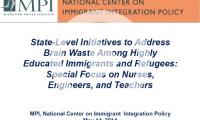Postsecondary Education
Recent Activity

A discussion of data compiled by MPI on "brain waste" among foreign-trained nurses, engineers, and teachers, with updates on three state-level initiatives—in Illinois, Massachusetts, and Washington State—that are working to analyze and address challenges faced by immigrants and refugees with degrees and training in these fields.

MPI experts, along with representatives from Gwinnett County Public Schools and the University of Georgia's Center for Latino Achievement and Success in Education, discuss the educational experiences of Georgia’s first- and second-generation immigrant youth and where Georgia’s ambitious education reforms have met—or failed to meet—the needs of this growing population.

Join MPI as U.S. Citizenship and Immigration Services Director Alejandro Mayorkas discusses the application process and policies that the agency has announced to implement the administration’s deferred action program.






















